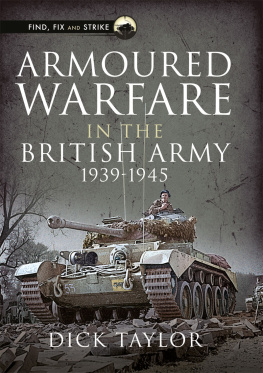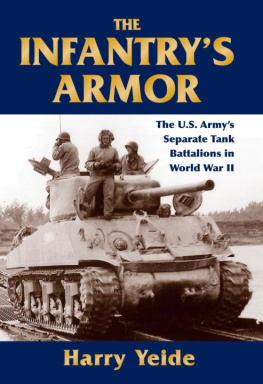Pagebreaks of the print version

CRUSADER
General Donn Starry and the Army of His Times
MIKE GUARDIA
Published in the United States of America and Great Britain in 2018 by
CASEMATE PUBLISHERS
1950 Lawrence Road, Havertown, PA 19083, USA
and
The Old Music Hall, 106108 Cowley Road, Oxford OX4 1JE, UK
Copyright 2018 Mike Guardia
Hardcover Edition: ISBN 978-1-61200-544-7
Digital Edition: ISBN 978-1-61200-545-4
Kindle Edition: ISBN 978-1-61200-545-4
A CIP record for this book is available from the British Library
All rights reserved. No part of this book may be reproduced or transmitted in any form or by any means, electronic or mechanical including photocopying, recording or by any information storage and retrieval system, without permission from the publisher in writing.
For a complete list of Casemate titles, please contact:
CASEMATE PUBLISHERS (US)
Telephone (610) 853-9131
Fax (610) 853-9146
Email:
www.casematepublishers.com
CASEMATE PUBLISHERS (UK)
Telephone (01865) 241249
Email:
www.casematepublishers.co.uk
For Marie and Melanie
Also by Mike Guardia:
American Guerrilla
Shadow Commander
Hal Moore
The Fires of Babylon
Foreword
I first met Donn Starry in 1973. I was a young West Point cadet on summer training at Fort Knox. He was the 2-star Commanding General of the US Army Armor Center. If I had any doubts about whether I would remain at West Point, and any doubts about whether I wanted to be an infantryman, artilleryman, or a cavalryman when I graduated, he erased them. General Donn Starry was a courageous warrior, a once-in-a-generation thinker, a gifted writer and speaker, and uncommonly engaging with senior and junior soldiers alike. He was, quite simply, the officer I wanted to emulate in my own career.
Mike Guardia chronicles the career of this superb, transformative leader. Drawing on a wealth of both serious and amusing anecdotes, he captures the essence of Donn Starrys leadership over the course of his long and illustrious career.
In 1981, I met Donn Starry again. Due in no small part to his inspiration, I had remained in the Army, and I was serving in a cavalry squadron in Colorado. He was the 4-star Commanding General of US Army Training and Doctrine Command. It was a perfect fit for this warrior-scholar. He had come to Fort Carson to introduce the Armys new doctrineAirLand Battle. Ever the thinker, ever the teacher, he was almost single-handedly changing the way the Army thought about maneuver warfare.
Mike Guardias story is especially persuasive on this point. Donn Starry redefined modern, maneuver warfare and set the Army on a path of rigorous and relevant training and education, many elements of which persist today.
The last time I met General Starry was in 2010. I had become the 4-star Commanding General of US Army Training and Doctrine Command. He had agreed to visit and to compare the challenges he faced in Training and Doctrine Command post-Vietnam to the challenges I faced as the wars in Iraq and Afghanistan began to slow down and other challenges in Europe and Asia began to emerge. He was impressive, as always, and helped me see things with his rich and thoughtful historical perspective, a perspective that contributed to changes we would eventually make in our leader development model. He died a year later, a leader of consequence to the end.
In the course of US military history, the greatest accolades go to the Generals and Admirals who are victorious in the decisive battles on land, at sea, and in the air. It is ironic that those who take on the harder task of preparing our military for war during time of peace are often forgotten. It is my hope that Mike Guardias Crusader: General Donn Starry and the Army of His Times will ensure that this great military leader is not forgotten.
General Martin E. Dempsey (USA, ret)
18th Chairman of the Joint Chiefs of Staff
37th Chief of Staff of the Army
Introduction
May 1970: Increasingly frustrated by the Communist incursions into South Vietnam, the US launched a full-scale attack against the enemys strongholds in southern Cambodia. At the tip of the spear was Colonel Donn A. Starry, commander of the 11th Armored Cavalry Regiment. Mounted atop their M48 Main Battle Tanks and M113 Armored Cavalry Assault Vehicles, Starrys regiment squared off against several thousand North Vietnamese and Viet Cong operating in the Cambodian borderlands. Although critically wounded on the front lines, Starry rallied his men to a decisive victory that captured the largest enemy cache in the region. For his audacious leadership and courage under fire, Starry was awarded both the Silver Star and Bronze Star Medals.
A 1948 West Point graduate, Starry entered the officer ranks during the inaugural years of the Cold War. Although he missed combat in World War II and Korea, Donn Starry became one of the most influential commanders of the Vietnam War. In a conflict dominated by airmobile infantry, Starry was a leading advocate for tank warfare in Vietnam. As a member of the Mechanized and Armor Combat Operations in Vietnam (MACOV) study group, his recommendations helped shape the contours for the use of American armor in Southeast Asia.
Following his tour of duty in Vietnam, Starry took command of the US V Corps, forward-stationed in West Germany. At the time, the US Army had shifted its doctrinal focus away from counterinsurgency and back towards the conventional defense of Western Europe. However, Starry noticed that the current doctrine for defending Europea plan known as Active Defensewas fundamentally flawed. In response, he created a new doctrine known as AirLand Battle, which emphasized small-unit initiative, synchronization of airground assets, and striking at the enemys rear echelons before he had a chance to mobilize them. Codified in the 1982 edition of Field Manual (FM) 100-5 Operations , AirLand Battle paved the way for the US Armys decisive victory during Operation Desert Storm . Starry retired as a four-star general in 1983.
Like most battlefield commanders from the Vietnam era, Starrys legacy is often overshadowed by the controversy of the war itself and the turmoil of the immediate postwar Army. However, with the development of AirLand Battle, it is hard to imagine anyone who has had a greater impact on modern maneuver warfare.
The idea for Crusader began in the summer of 2010 when I was a young armor officer in the US Army. Starry remains highly revered within the armor community and I learned much about him during my time at the Armor Officer Basic Course. When I began researching this project, Starry was still living but had been suffering from a rare form of cancer. Although his family gave me their blessing to pursue the biography, they politely declined my request to interview the elder Starry given the precarious nature of his health. Nevertheless, each member of the family selflessly gave their time and energy piecing together the information needed for this book. Donn Starry tragically lost his battle with cancer on August 26, 2011. He was 86 years old.
Throughout his career, Donn Starry was a prolific author. During my time as a junior officer, I read many of his works on armored warfare. His seminal text, Mounted Combat in Vietnam , explored the use of American armor in a war dominated by light and airmobile infantry. Mounted Combat in Vietnam was the last installment of the 13-part Vietnam Studies series commissioned by the Army Center of Military History. Starrys book, however, was the only one in the series to be completed after the war, thereby offering a full account of armor and mechanized operations while the other installments covered their respective topics up until about 1971. Together with historian George F. Hoffman, Starry also wrote and edited From Camp Colt to Desert Storm , a complete history of American armor operations from the World War I-era Tank Corps to the Gulf War tank battles at 73 Easting and Medina Ridge. Other works by Starry include his numerous articles written for Military Review and Armor Magazine .

















